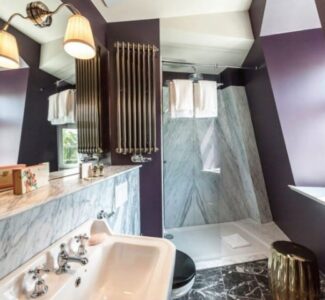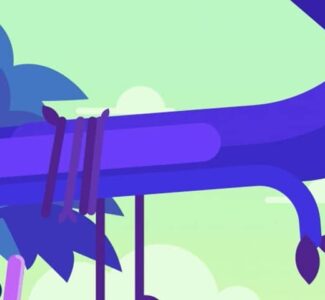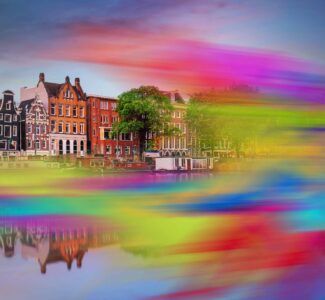Royal Van Wijhe Verf, Dijkstra Plastics and Veolia Polymers have joined forces and come up with the first paint container, which is made of 100% Post Consumer Recyclate (PCR). This is an important step towards a fully circular system. “It is a shame to use ‘virgin material’ for paint containers,” says Gerrit Klein Nagelvoort of Veolia Polymers. “With this initiative we show that you can perfectly make these containers of Post-Consumer Recyclate. And they look beautiful.”
Extensively tested for quality
Of course, all this has been extensively tested. “You don’t want to run the risk of the container snapping after you have filled it with expensive paint,” says Remy Notten of Dijkstra Plastics. That’s why, for example, Van Wijhe Verf filled the containers with sand and water to test whether damage would occur during loading, unloading and transport. That was not the case. “We have proven that it is possible: a perfect paint container from consumer waste.” The new PCR bucket was put into production in May and everyone, including the customer, is very satisfied.
Circular production
“We’ve been making plastic containers for over forty years,” says Notten. “A few years ago, it still was a neutral product with good characteristics, which brought us comfort and raised our standard of living. But it’s the Plastic Soup in particular that has made us realise that the material doesn’t just disappear and that we can’t continue to produce in this linear way. Circular production is the way to prevent depletion of the earth.”
“We still too much think that there is an unlimited flow of new raw materials, but that is not the case,” says Klein Nagelvoort. “By using ‘virgin material’, you can open the oil tap again. This can be done for medical applications or for food purposes, but not for paint containers that immediately end up back in the waste after use. That is abuse of new material,” he explains.
A different colour
Nevertheless, according to Klein Nagelvoort, many paint producers have cold feet. “We get so many different colours of plastic that we can never turn it into a snow-white container again, so the colour is solid anthracite.” This was also the case with the containers from Post Industrial Recyclate. “Wijzonol white wall paint was always in a white container. That was a tradition in the world of paint. Then you have to stand firm to do things differently,” says Beek about this. Yet that is exactly what these three companies have done together.
Recycling
“Circular production is of course not new,” says Notten. “With paper, cardboard and glass this has been done for years and we are completely used to it, but with plastics it is still in its infancy. “We are fine with drinking our expensive wine from a bottle of recycled glass,” says Klein Nagelvoort. “And the first recycled paper was grey,” he recalls. “That too was fine by us, because then you could clearly see that it was recycled. In the meantime, the developments have reached such a point that the recycled paper is also white as snow. We’re not ready yet for plastic, but who knows, we might be able to make containers in beautiful colours in the future. These developments do not stand still either.
Overijssel innovates: recyclable paint container
Future plans
“We are always looking for ways to improve our sustainability performance,” says Beek. “It is for good reason that Royal Van Wijhe Verf was the first chemical company to be B Corp certified since 2016. You’re never done, but that makes it interesting. It would be nice if a used paint container could be recycled in the future. To do this, we have to find a way to remove the paint residues in such a way that the container can be used as a new raw material again. Then we’ll have made the paint container completely circular.”
The cooperation between the three companies goes much further than just making paint containers circular. “We have developed an antimicrobial supplement for paint, but we see wider possibilities,” says Beek. “By using this supplement in the production of recycled plastic containers, you could also use it, for example, for food packaging in the future. That would be a great next step in this special collaboration.”
Overijssel
“We are three companies from Overijssel that have met at the Polymer Science Park in Zwolle,” says Notten. “We are also working within the province on the regional transition agenda in the field of plastics. We also look at transport, for example: it would be nice if you could collect and process plastic locally as much as possible. That makes a difference. Cooperation at provincial level shortens the lines and reduces the burden on the environment”.
Return points
“We process 45,000 tons of consumer waste per year. Of this, 30,000 tonnes come from packaging waste and 15,000 tonnes comes via the municipal amenities site,” says Klein Nagelvoort. “Plastic waste still needs to be deposited at the municipal depot. It would be nice if, for example, a collection point could be set up at the DIY store or if a container would carry a deposit. Separating waste is also an option to make it easier for consumers to recycle plastics.”
One step further
The paint containers were made from Post Industrial Recyclate, i.e. unused plastic that was left over from other production processes. “With PCR containers we go a step further,” explains Menno Beek of Van Wijhe Verf. “We now use plastic, which has been used by the consumer and recycled .” Veolia Polymers processes this into so-called granules, which Dijkstra Plastics then uses to produce PCR containers for Van Wijhe Verf.


